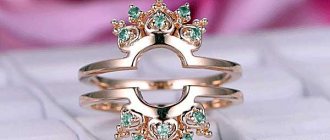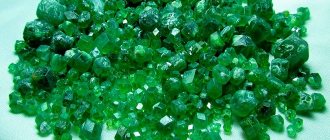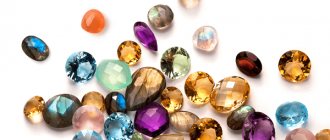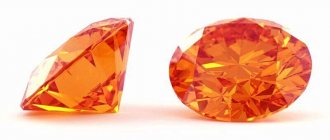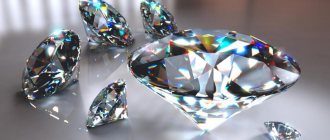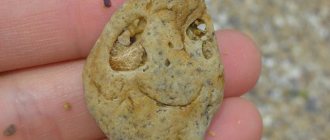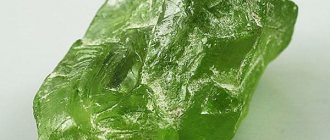Precious stones are rare minerals that have natural beauty, which in most cases manifests itself after jewelry processing. In addition to their amazing external shapes and colors, these minerals have exceptional durability and incredible strength. That is why they have a very high price, are placed in closed storage facilities and well-protected collections. And they are used as financial assets in banking.
- Cut
All forms and methods of legal regulation in this area are carried out on the basis of Federal Law No. 41-FZ of March 26, 1998 “On Precious Metals and Precious Stones”.
Main characteristics
Rarity
A quality that determines the frequency of occurrence of a mineral in nature. Precious stones possess it to the fullest. Some of them are so unique that they are found in one or several copies. However, this characteristic can easily change in one direction or another due to the discovery of new deposits, or vice versa - cessation of production due to depletion of deposits.
In this regard, carmeltazite is of particular interest - a stone that arrived on Earth from outer space. Also quite curious in this regard is the future development of mineral resources of nearby planets and asteroids, which may entail a change in the level of rarity of terrestrial gems.
Durability
It is this property of precious stones that allows them to remain unchanged for centuries. Durability is based on mechanical strength, determined by hardness, fragility, and resistance to mechanical, temperature and chemical influences.
beauty
The beauty of precious stones makes an indelible impression on any person. Thanks to it, value is formed, the desire to possess unique value is manifested and decorate it with skillful framing, creating unsurpassed jewelry. The concepts of beauty of precious stones include:
- color and reflective qualities,
- ability to take an elegant geometric shape,
- the ability to have a highly polished surface.
Story
Interest in the Urals did not arise immediately. For a long time, no one suspected the precious stones hiding under the rock layers. For the first time, residents of villages located around the Adui River started talking about gems. Illiterate peasants did not know the value of the stones they mined, so they used them in craft production, without trying to sell or exchange them. Only a century later, at the beginning of the 19th century, the first real prospectors appeared on Adua. They mined beryls and amethysts in large quantities and sold them for a lot of money, including abroad.
It was during this period that the areas around the villages of Shaitanka, Koltasha and Lipovskoye became famous not only throughout Russia, but also became known throughout the world. Every year, large numbers of rubies, sapphires, amethysts, tourmalines and topazes were found here. The extraction of precious stones was carried out intensively, but had a spontaneous and even seasonal nature. There were very few real miners.
Stones were mined in winter by peasants, for whom they were a way to feed their families. Farming did not generate income, so armed with ropes, chisels and cutters, peasants went to the mountains, where they hollowed out passages in the ground that bore little resemblance to modern mines. Working in such mines was very dangerous; there were no supports in the narrow passages, and nothing protected the miners from collapse.
Ural amethyst
For several months, prospectors worked in the mountains, but with the onset of sowing time, they left their homes and, having sold their spoils to resellers on duty right there, went to the villages.
Mining in mines, quarries and placers
The main methods of mining gemstones currently are:
- Washing in placers. Stones that have fallen to the surface of the earth under the influence of water currents are found by manually washing the soil or slag.
- Organization of an open pit. Involves excavation work, often with the use of explosions, the use of drilling rigs, heavy machinery, and special equipment. Direct methods for finding stones vary depending on the rock and size of the minerals.
- Mining. The most expensive and risky mining method, which is resorted to only if there is confidence in the presence of precious stones in the veins being mined.
To organize the extraction of minerals, mining enterprises are created, equipped with modern equipment and qualified personnel: copies, mines, mines. Although, private manual mining also takes place in a number of countries around the world.
What stones are mined in Russia?
Currently, the division of stones into semi-precious and precious is a convention. The value of minerals is determined depending on their appearance, physical properties and rarity. According to the legislation of the Russian Federation, diamonds, alexandrite, rubies, blue sapphires, emeralds and pearls are considered precious stones. However, many other minerals have been found in Russia, which in many countries are considered rare and especially valuable.
Precious Gems
Russian diamonds have been found in several areas. The purest specimens are those mined in the Urals and Yakutia. The richest deposits are located in the Republic of Sakha. The deposits are estimated at more than 700 million carats. Deposits in the Arkhangelsk region are estimated at 219 million carats, and in the Krasnoyarsk Territory - 75 million carats.
Diamond mining in Yakutia
Diamonds were also discovered in the Irkutsk, Voronezh, Bryansk regions, the republics of Bashkortostan, Komi, Karelia, Primorsky and Perm Territories. Currently, Russia provides more than 20% of the diamond market.
Not far from Yekaterinburg, unique transparent emeralds of rich green color are being mined. However, their number is limited. Most often, low-quality emeralds are found in the Urals.
Rubies were discovered in the Sverdlovsk and Chelyabinsk regions. Their deposits are insignificant, but unique, especially valuable samples are found. Blue sapphires can be found in small quantities in the Ilmen Mountains and Kyshtym region.
Semiprecious stones
Semi-precious stones are found in the central part of the country, but the most significant deposits are concentrated in the northeast. Active development is carried out in the Yamalo-Nenets District, in the Chelyabinsk and Sverdlovsk regions, in the Urals, in the area of Lake Baikal and Yekaterinburg. The following semi-precious stones have been discovered in Russian mineral resources:
Lesser-known semi-precious and ornamental stones have also been found in Russian mineral resources: verdelite, pumpelliite, moyukite, prehnite, stilbite, xonotlite, charoite. In small quantities in Makhachkala there is rock crystal, carnelian, agate and chalcedony. In 2011, a new mineral was discovered in the Sverdlovsk mines - Mariinskite. Researchers believe that it can be classified as a group of precious gems.
Types of processing
First of all, I would like to bring some clarity to the very concept of processing. The fact is that some experts by this term mean “refinement” of precious stones, which represents diffusion, impregnation and thermal effects. Excluding all types of mechanical impact.
Indeed, these methods significantly improve the color qualities of stones and increase their “longevity”. True, in this case the crystal lattice and the chemical composition of the mineral itself change significantly. With a purely mechanical effect, this does not happen, since it affects only the outer part of the stone.
Cut
The process of forming facets on the surface of a gemstone is called cutting.
Diamond
This type of cut is most used in diamond processing, although a number of other precious stones are also processed with its help. Its ultimate goal is to give the product a diamond shape. With the help of which complete internal light reflection is achieved. As a result, a beam of light is reflected twice from the opposite rear edges and exits the front part.
Diamonds have been cut this way for centuries. First single, and then double, triple, and also round brilliant cut. The process of creating new forms continues today, but in accordance with the requirements of the World Diamond Union and the Scandinavian Diamond Nomenclature.
Emerald
A rather rare cut, invented in the middle of the last millennium. It has more than 50 edges laid out in several rows. A stone processed in this way is shaped like an ancient multi-stage Aztec temple, albeit octagonal in shape with slightly beveled corners.
Mixed
The mixed shape combines smooth and faceted cuts. The stone becomes smooth on one side, and becomes covered with edges on the other. True, nowadays such a combination on one side of the finished jewelry is becoming increasingly popular.
Stepped
The beveled edges (facets) are located one above the other - in steps, resulting in a polygonal area. The side faces will be made in the form of trapezoids or isosceles triangles.
Briolette cut
Drop-shaped stones are often processed with the ancient briolette cut, which allows the gem to shine brightly with many (usually 56) triangular facets.
Pear cut
A specific cut shape, again a teardrop-shaped stone, associated with the creation of 55-56 facets. Fixed with a tapered end in the frame, the finished product gives the owner sophistication and sophistication, visually lengthening the neck.
Marquise cut
A product that has undergone this type of cutting resembles in shape an elongated oval with sharp ends, covered with 55 edges. Which obviously symbolizes the wicked smile of the Marquise de Pompadour, or the less romantic boat.
Wedge cut
This method of stone processing is based on triangles. Four tetrahedral pyramids are lateral faces. The lower part of the stone is twice as high as the upper component.
Pandelok cut
Drop-shaped pendants are called pandelok. This is the method used to cut the stones that make up brooches, earrings, and pendants. Pandelok cut one of the largest Cullian diamonds - I and the largest brown diamond discovered in 1967, with an original weight of 249 metric carats.
Rose cut
The peculiarity of this type of cut is the flat base of the stone, covered in the upper part with triangles. Usually their number is 12 or 24. The “Antwerp”, “Dutch”, “double Dutch”, “half-Dutch” rose cut, popular in the 16th century, has lost its relevance today.
Table cut
The simplest type of stone processing, most used in the manufacture of signet rings. It consists of two rectangles stacked vertically on top of each other.
Cabochon
Polishing of ornamental and precious stones is called cabochon. The finished product takes on a smooth, convex, well-polished shape. Something similar can be seen on the most ordinary decorative buttons.
This type of processing is practiced for stones that do not have natural optical effects, but have a pleasant color and suitable shape. Some of them look most impressive when processed as a cabochon. This:
- turquoise,
- noble opal,
- “star” ruby and sapphire,
- "moon eye"
- "cat stone"
- hairy
Stone carving
Stone carving is one of the oldest decorative and applied arts, which reached perfection in Ancient Egypt and became widespread. Using the simplest tools, the craftsmen of their time very skillfully carried out sawing, turning, drilling, engraving, polishing, and polishing the manufactured products.
Glyptics
The art of carving on precious, semi-precious, and patterned stones is called glyptics, which is most used in small forms. One of the most ancient among known arts, the works of which became famous among the Assyrians, Babylonians, Egyptians and Sumerians. However, these products, manufactured in the form of:
- intaglios - in-depth reliefs,
- cameos - convex shapes in the form of bas-reliefs,
reached in Ancient Greece and Italy.
It is quite natural that the best works of glyptic masters adorn the shelves of the most famous museums and galleries in the world.
Netsuke
Japanese keychains made in the form of miniature sculptures. At one time they played the role of a counterweight and elegant decoration of clothes without pockets. In past centuries, this direction of decorative and applied art became widespread in Japan. Even schools of netsukeshi carvers arose, leaving their mark on the history of this country.
Netsuke made today are in the nature of low-grade souvenir products of assembly line production. Although there are quite valuable collectible works made by professionals and sold at major American auctions.
Inlay
A broad collective term that includes a variety of decoration techniques. From vast areas of city buildings and squares to the smallest handicrafts. This ancient technique falls into many directions and at the same time uses a variety of natural and modern synthesized materials, skillfully decorating any surface.
Florentine mosaic
Florentine mosaic is the art of inlaying smooth surfaces with decorative plates, forming a solid picture and highly artistic ornament. The plates themselves are usually made of marble or precious, semi-precious and ornamental stones.
This technique reached its greatest flowering in Florence in the 16th century. However, a little later in India, the art of “parchinkari”, borrowed from Florentine mosaics, appeared, examples of which adorn the famous Taj Mahal and more modern marble tabletops.
Galtovka
Modernity has brought unification and continuous machine production to the technology of processing precious stones. One example of such a technique is tumbling - a mechanical abrasive surface treatment carried out inside tumbling drums and vibrating machines. Their fillers are tumbling bodies: granules, abrasives, chips (for jewelry).
Through rotation or vibration inside the unit, the desired effect on the future product is created. Processed in this way:
- metals, wood, minerals, stones;
- polymers, glass, ceramics.
The result of tumbling is an improvement in the surface quality of the processed material.
Scope of application
Directions for using precious stones:
- Jewelry industry. The use of gemstones to make jewelry is a long-standing tradition. It is there that these rare minerals show all their beauty and perfection, the richness of colors and the play of color. Enclosed in a frame, sometimes made of precious metals, they are of great value, determined by the size of the stone, its type and appearance, the skill of processing and the uniqueness of the product.
- Dynastic symbolism. Since ancient times, monarchs have learned to use gems as symbols of their power and might. Crowns, tiaras, sovereign apples, scepters, chains, and sometimes the throne itself were always studded with the most magnificent precious stones. A little later, award orders and shoulder straps of major military leaders were added to them.
- Religion and cult. The beauty of stones was long ago appreciated by the clergy and put at the service of religion. Religious objects, icons, various utensils, and sometimes the minerals themselves constitute the necessary attributes of many world beliefs.
- Medicine and cosmetics. The modern medical industry skillfully uses the unique properties of precious stones. Scalpels with diamond coating, modeling underwear based on diamond powder, braces made of artificial sapphires, ruby and sapphire lasers, pearl powder, succinic acid, tourmaline air ionizers - this is not a complete list of means that help in curing a wide variety of diseases. Cosmetics are also keeping up with medicine, using a wide range of powders with finely ground precious minerals to give the skin a youthful appearance.
- Industry. The use of precious stones in industry is very wide, precisely due to the many special properties. The hardness of diamonds is in demand in the manufacture of a significant arsenal of cutting tools; the luminous qualities of minerals are highly valued in optics, as well as in the manufacture of lasers and nuclear energy; chemical resistance is indispensable when conducting particularly complex studies. In addition, sapphire is capable of absorbing infrared radiation, and artificial rubies and sapphires (real ones were used until the beginning of the 20th century) are irreplaceable in the manufacture of mechanical watches.
- Payment and storage facility. Since ancient times, precious stones have been used as a means of payment. Today they have high investment attractiveness, and are also used as financial assets in banking operations.
Magic Gems
Surprisingly, there is no other place in the world as rich in precious stones as the Urals. It is here that you can find in great abundance:
- Amethyst. A uniquely beautiful stone. It is mined not only in the Urals, but it is the Ural amethyst that is valued somewhat more expensive. The high cost is due to the special play of light, which does not disappear even with artificial lighting. The stone sparkles and shimmers in any lighting conditions. Its color can be different: depending on the content of impurities, amethyst may have no color at all, or have a beautiful light or dark purple hue. There are also quite unusual specimens. Thus, blood-colored amethysts were found in the Murzinka area. When the sun's rays hit the stone, they begin to sparkle with red reflections.
- Topaz. It was first found in the Urals in 1772. Colorless or slightly blue topazes were found in the Ilmen Mountains by a Cossack named Prutov. Since this time, topazes have been found in shades of pink, brown, purple, gold, yellow and red. The stone is hard, but its structure is fragile. The specific gravity and density of topaz is large; it is considered a heavy mineral. Its color may change depending on the temperature.
- Demantoid. It was discovered in 1868 during the development of placers at the Nizhne Tagil plant. A uniquely beautiful stone, the color of which changes depending on which part of it is illuminated by light. Shades can vary from golden honey to emerald and even green. When the stone is destroyed, golden-yellow bissolite crystals can be discovered.
- Mariinsky. A gem discovered quite late. The discovery occurred in the Mariinskoye field in 2012. The composition of mariinskite is in many ways similar to the composition of alexandrite. When exposed to light, Mariinskite does not change color, which significantly distinguishes it from other stones. The color of the stone is dark green, its refractive index and strength are high, which makes it similar to diamonds.
- Alexandrite. When exposed to light, the stone changes its color. It was first found in the Malyshevskoye deposit.
- Sapphire. The stone is predominantly blue in color and is an aluminum oxide. Used to make jewelry.
- Ruby. The stone is red, a relative of sapphire. Can be found on all continents, in the Urals it is found in isolated cases, used for making jewelry. The cost of a ruby depends on the shade. Sapphires and rubies in Russia were known as “yakhont”.
- Beryl. Found in 1828 in the Murzinka area. The color of beryl can be green, white or gray. The stone is opaque. Used to make precious jewelry.
- Emerald. A variety of beryl with a bright green hue. The gemstone has sufficient strength and great weight. The stone is transparent, some emeralds are valued several times more expensive than diamonds. Emerald mines in the Urals were discovered in 1831. Stone mining is still carried out today.
When considering Ural stones, special attention should be paid to malachite. Green stone, with a radial fibrous structure, was used for making handicrafts. Malachite boxes, vases, tables, chests and other interior items decorated the homes of many families. In addition, malachite was used to search for copper ore, since its deposits were located as close as possible to each other. Today, malachite is practically not mined in Russia; its deposits have dried up. In addition, stones such as rubies and sapphires can be obtained artificially, which makes their extraction unprofitable.
Deposits in Russia and the world
The south of our planet is richest in deposits of precious stones. These are: South America, southern Africa, southern Asia and Australia. The most significant deposits by country of the world are located:
- Diamonds in South Africa, Angola, Tanzania, Congo, Zimbabwe, Russia. India and Brazil have now lost their diamond mining positions in the world market.
- Chrysoberyls in Brazil, Zimbabwe, Russia (the deposits have now been worked out) and Sri Lanka.
- Corundums in Sri Lanka, India, Myanmar.
- Sapphires in Sri Lanka, India, Kampuchea, Thailand, Myanmar.
- Opals in Australia, Mexico, USA, Brazil, Ethiopia, Russia.
- Emeralds in Colombia, Zimbabwe, South Africa.

